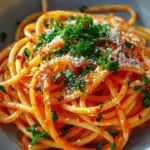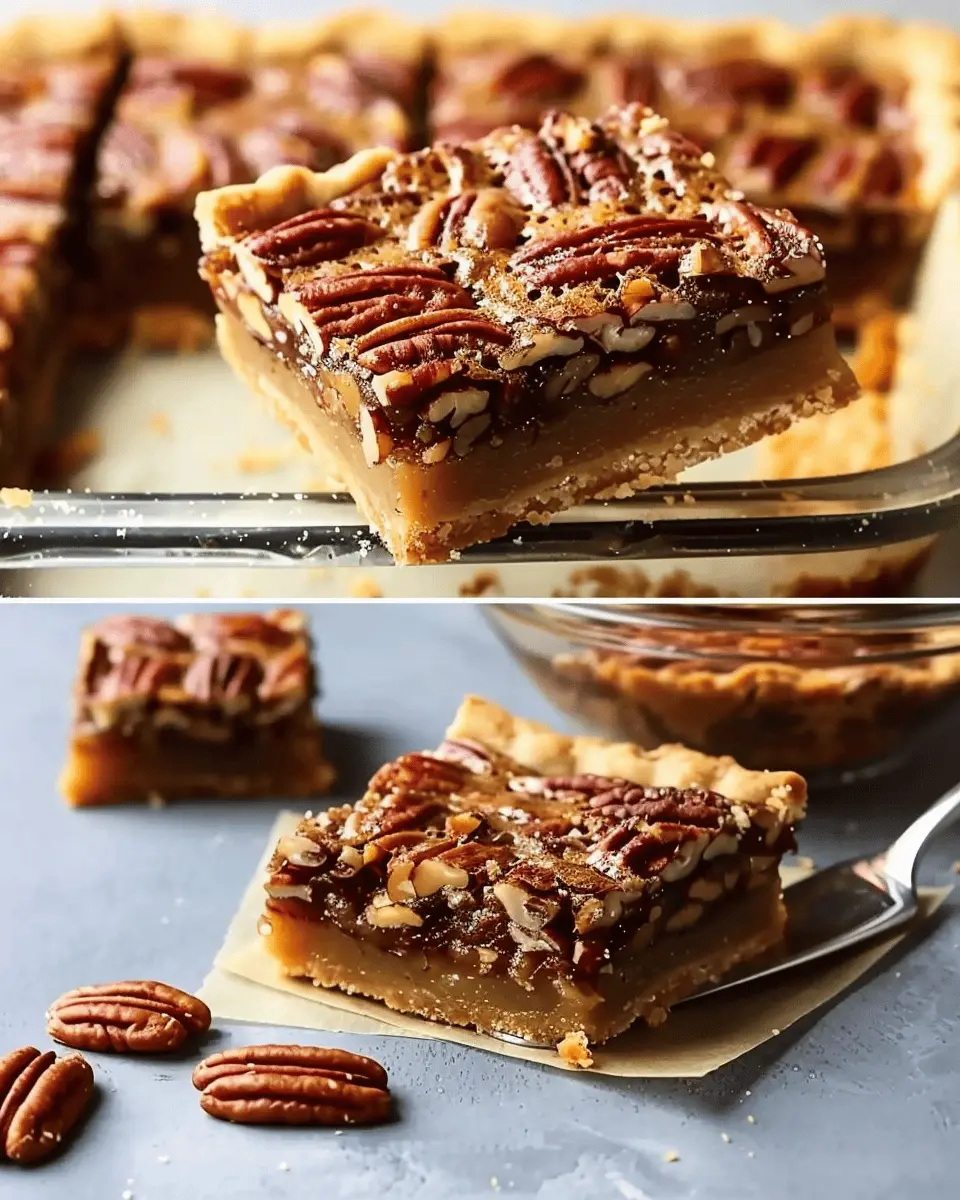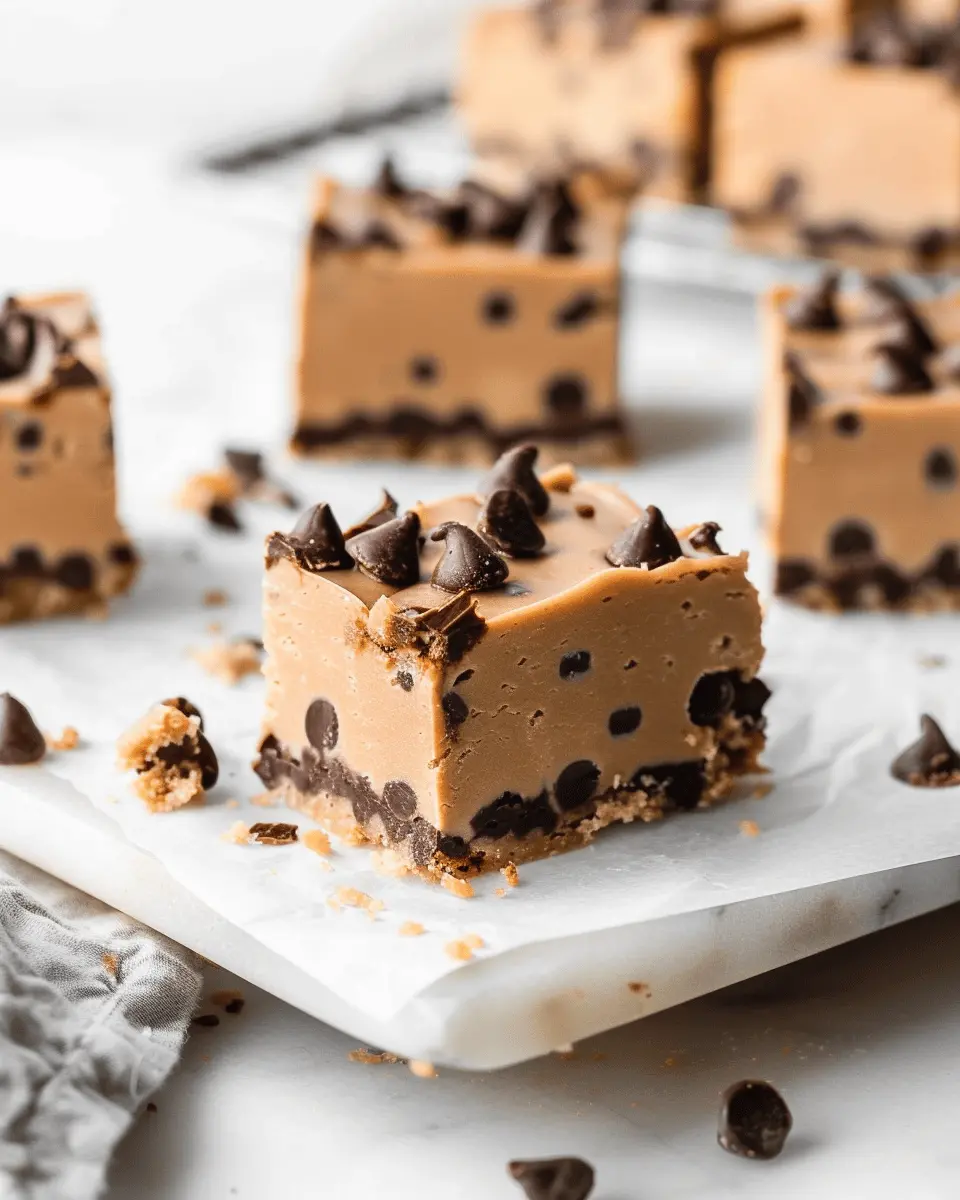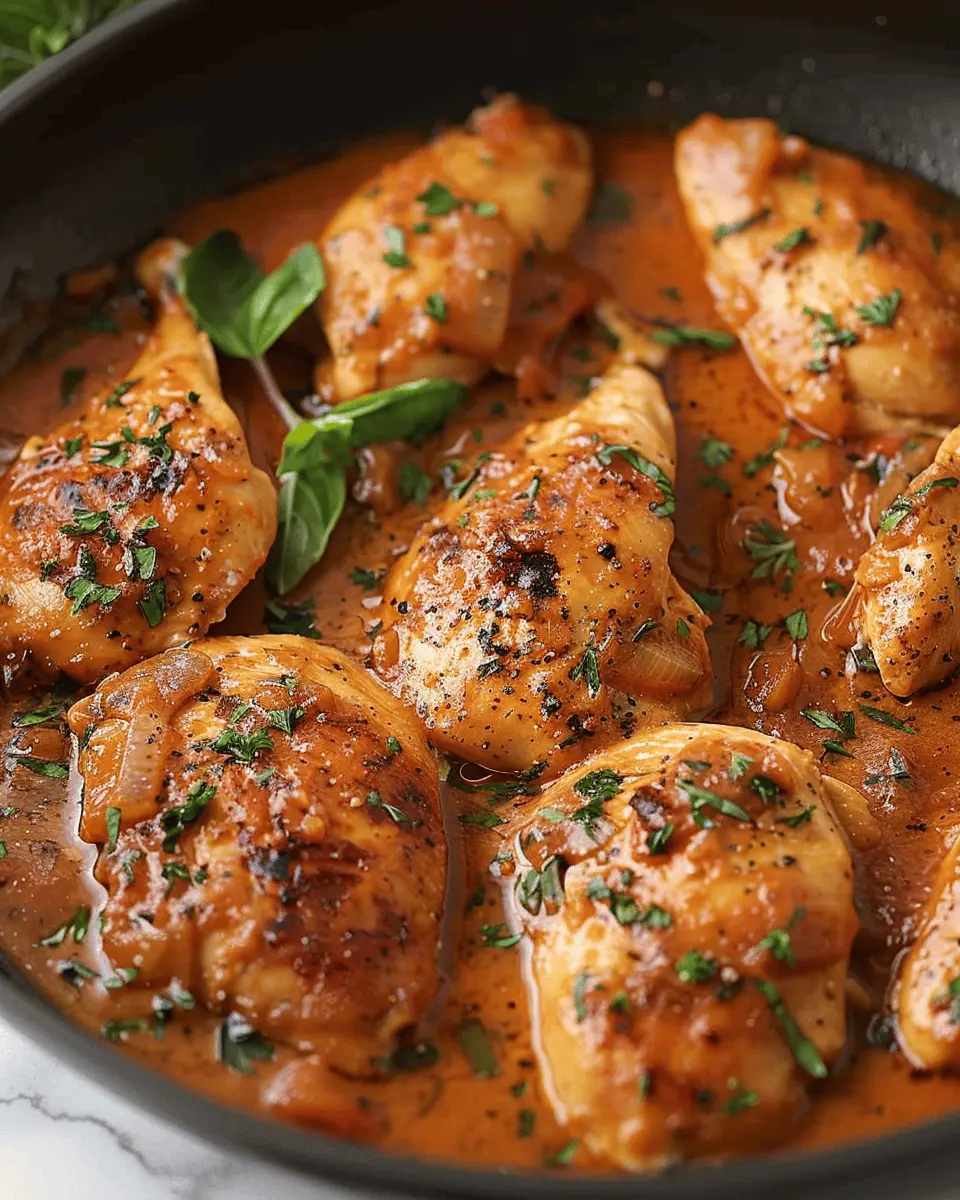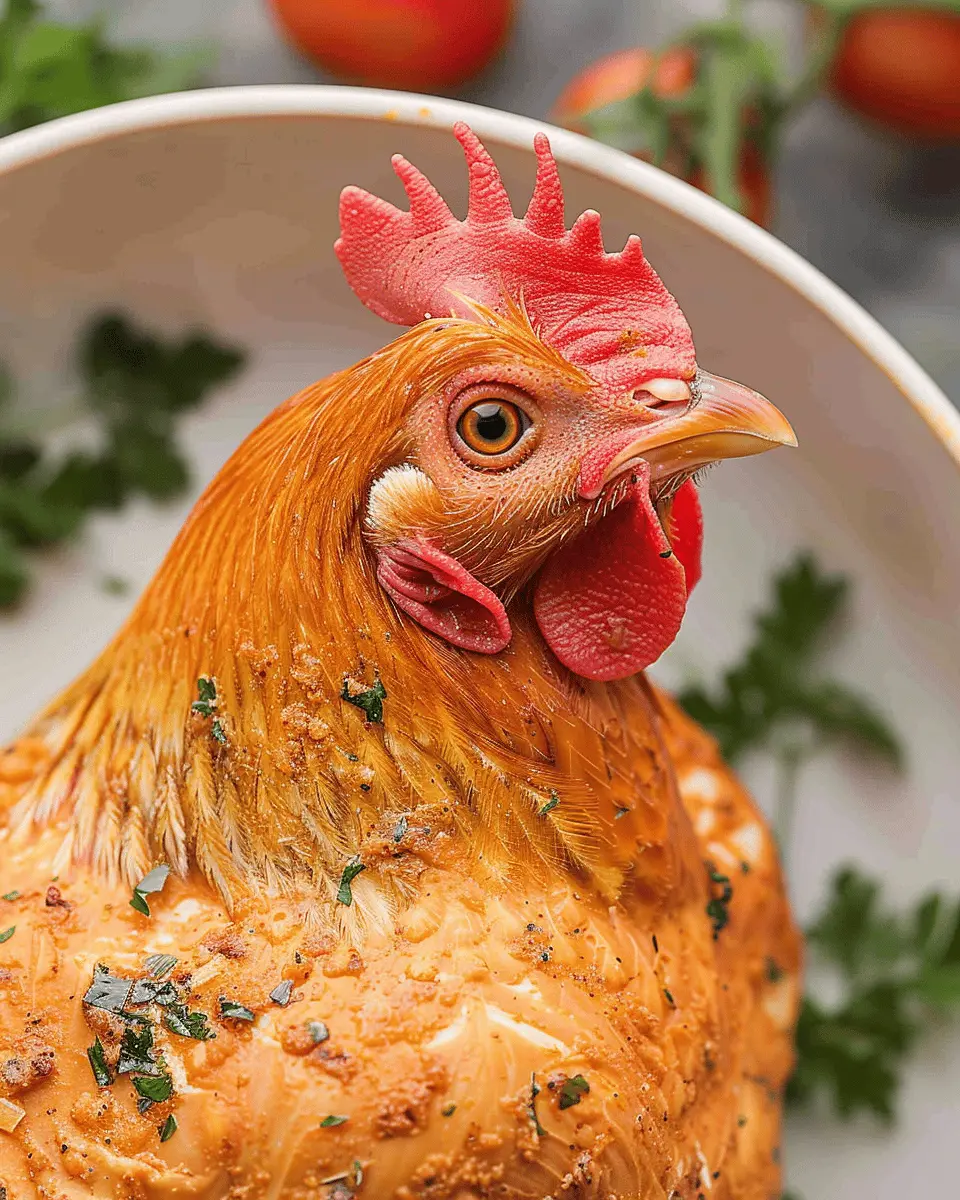Introduction to Gochujang Pasta
When it comes to creating a satisfying homemade meal, gochujang pasta might just be the dish you never knew you needed. Combining the heat of Korean gochujang sauce with the comforting appeal of pasta, this recipe offers an exotic twist on a traditional favorite. Perfect for busy weeknights or lazy Sundays, it’s an easy way to impress guests or treat yourself to a flavorful dinner in just under 30 minutes.
So, why exactly is gochujang pasta such a great choice? For starters, the deep umami flavor of gochujang—a fermented chili paste—is not just tasty; it’s packed with health benefits. According to a report by the Journal of Agricultural and Food Chemistry, fermented foods can improve digestive health and boost your immune system. So each spoonful of this savory sauce isn’t just delicious but can be beneficial for your well-being!
Let’s also talk about versatility. You can customize your gochujang pasta with a variety of proteins. Whether you prefer Turkey Bacon, Chicken Ham, or even plant-based options, the sauce clings beautifully to whatever ingredients you choose, making it a delightful dish for everyone at your table. Plus, the creaminess of the accompanying sauce pairs excellently with fresh veggies like spinach or bell peppers, enhancing both flavor and nutrition.
Curious about how to make it? The beauty of this recipe lies in its simplicity. Just a handful of ingredients—most of which you probably already have on hand—can lead to a stunning meal. Whether you’re entertaining friends, meal prepping for the week, or simply having a cozy dinner alone, gochujang pasta is a winner.
As you dive into this culinary adventure, you’ll find that the combination of heat, creaminess, and the unmistakable flavor of gochujang elevates the dish from everyday fare to something extraordinary. Ready to give it a whirl? Let’s jump into the recipe!
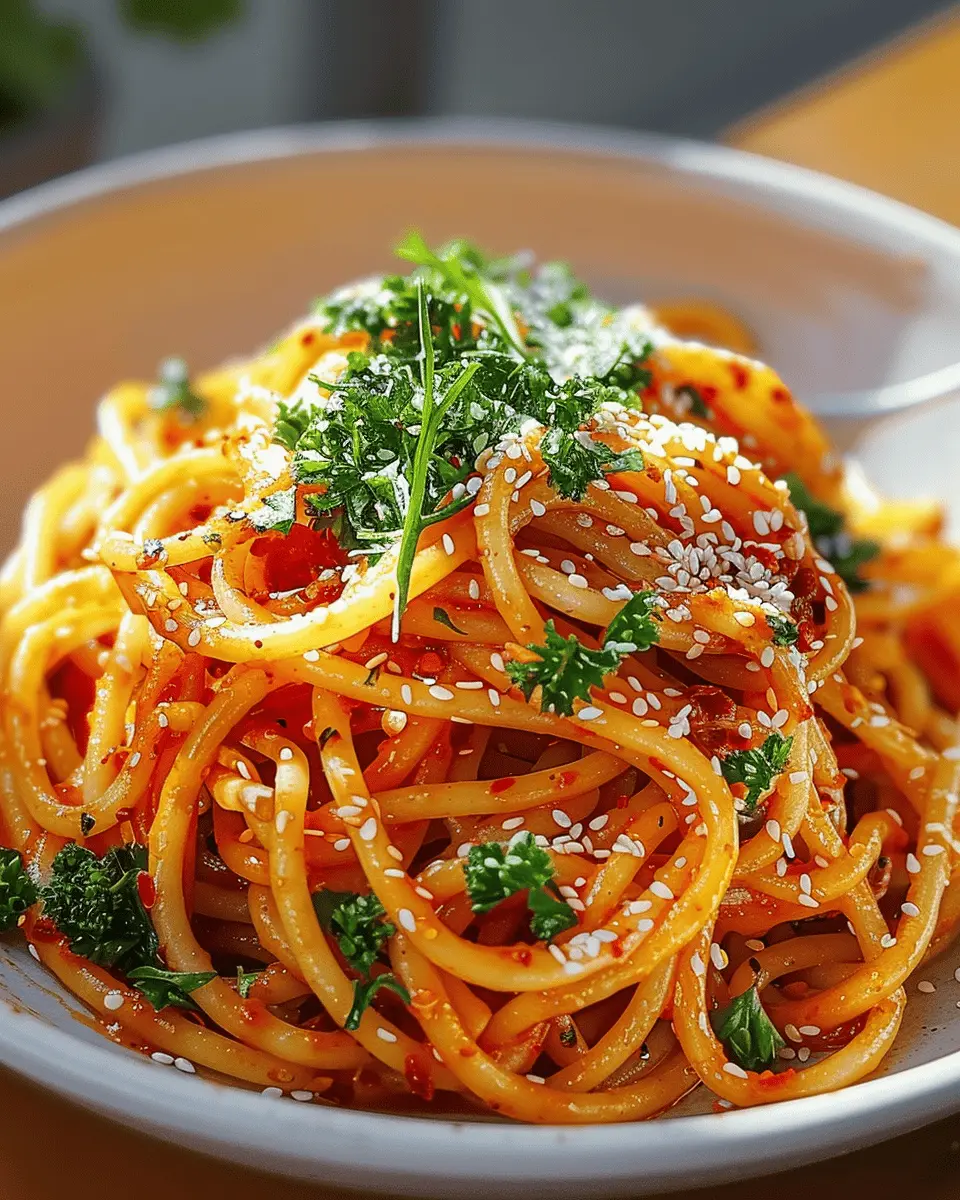
Ingredients for Gochujang Pasta
Essential Ingredients You’ll Need
Creating a delightful gochujang pasta experience starts with the right ingredients. Here’s what you’ll need:
- Pasta: Choose your favorite type—spaghetti, penne, or fusilli work beautifully.
- Gochujang: This fermented Korean chili paste is the star of the dish, bringing a wonderful depth of flavor.
- Garlic: Freshly minced garlic adds an aromatic touch that enhances the overall taste.
- Vegetables: Bell peppers, spinach, and carrots not only add color but also a burst of nutrition.
- Chicken Broth or Vegetable Broth: A base for your sauce that gives richness without overpowering the gochujang.
Optional Add-ons for Extra Flavor and Protein
Want to take your gochujang pasta to the next level? Consider these optional ingredients:
- Turkey Bacon: For a smoky crunch that complements the sauce perfectly.
- Chicken Ham: A lighter protein that incorporates well into the pasta.
- Tofu or Tempeh: Excellent for a vegetarian twist, with plenty of protein to keep you satisfied.
- Sesame oil: A drizzle at the end can elevate the dish with its nutty flavor.
Whether you’re dining solo or impressing friends, customizing your dish is just part of the fun! For more information on the nutritional benefits of these ingredients, check out resources like the USDA Food Data Central. Happy cooking!
Preparing Gochujang Pasta
Creating a bowl of gochujang pasta is not just about combining ingredients; it’s an adventure that infuses your meal with vibrant, spicy, and umami notes. In this section, I’ll guide you through the preparation of this delightful dish, ensuring every step is easy to follow and packed with flavor.
Create the Flavorful Gochujang Sauce
The star of gochujang pasta is undoubtedly the sauce. Start by gathering:
- 3 tablespoons of gochujang (Korean red chili paste)
- 2 tablespoons of soy sauce
- 1 tablespoon of sesame oil
- 1 tablespoon of honey or maple syrup (for a hint of sweetness)
- 1 teaspoon of minced garlic
- 1 teaspoon of minced ginger
In a mixing bowl, combine these ingredients and stir until you have a smooth and well-blended sauce. This sauce is the backbone of your dish and will bring depth to your pasta. Feel free to adjust the spice level to your liking by adding more or less gochujang. If you want to take this up a notch, consider adding a splash of lemon juice for brightness.
Cook the Pasta to Perfection
Choosing the right pasta is crucial, so opt for spaghetti, linguine, or even rice noodles for a gluten-free version. Bring a pot of water to a boil, adding a generous pinch of salt. Once boiling, add the pasta and cook according to the package instructions until al dente. Remember to save a cup of the pasta water before draining. This starchy water can help to ensure your sauce clings perfectly to the pasta!
Sauté Aromatics and Protein (Optional)
While your pasta cooks, you can enhance the dish by sautéing some aromatics and optional protein. In a skillet, heat a splash of olive oil over medium heat. Add:
- 1 small onion, finely chopped
- 1 bell pepper, sliced
- 1 cup of Turkey Bacon or Chicken Ham, chopped (or any protein of your choice)
Sauté for about 5-7 minutes until the onions are translucent and the protein is browned. These ingredients will add texture and an extra layer of flavor to your gochujang pasta. If you’re looking for plant-based options, consider tofu or tempeh for a protein boost.
Combine Pasta with the Sauce and Ingredients
Once your pasta is cooked and drained, return it to the pot. Pour in your prepared gochujang sauce, along with the sautéed vegetables and protein. Toss everything together gently. If the sauce seems too thick, gradually add some reserved pasta water until you reach your desired consistency. The goal is to have every strand coated beautifully with that lovely gochujang flavor.
Serve and Garnish for Presentation
Now comes the fun part—serving! Plate your gochujang pasta and feel free to get creative. Top with freshly chopped green onions, sesame seeds, or a drizzle of sesame oil for that extra pop. A sprinkle of cilantro can add a refreshing note, while a light squeeze of lime juice can brighten the dish even more. For a robust presentation, serve with a side of steamed vegetables or a simple salad.
Now, you’re ready to dig into this sensational bowl of gochujang pasta. It’s not only a feast for your palate but also an inviting dish that can impress guests or bring comfort to a cozy night in. Whether you’re experimenting with flavors or seeking a quick weeknight dinner, this pasta dish is a must-try. And don’t forget, your culinary adventure doesn’t stop here; there are endless possibilities to make this recipe your own!
Looking for more inspiration? Check out additional ideas on Korean cuisine flavors!
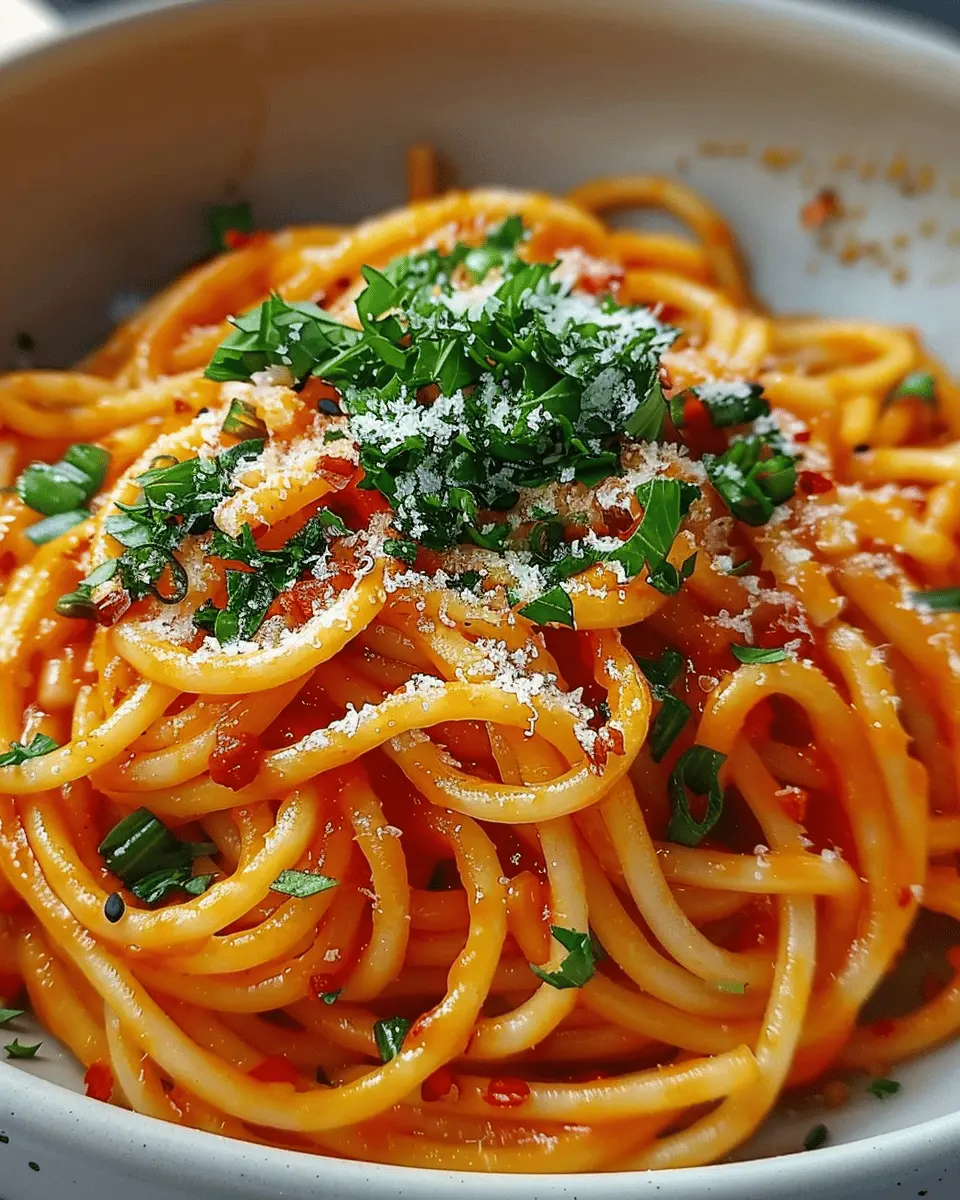
Variations on Gochujang Pasta
Exploring different variations of gochujang pasta can be an exciting adventure for your taste buds. Each twist offers a unique flavor profile that can elevate your weeknight dinner or impress your weekend guests. Let’s dive into some delightful options!
Vegetarian Gochujang Pasta
You don’t have to compromise on flavor to enjoy a vegetarian version of gochujang pasta. Simply swap the traditional proteins for a colorful mix of vegetables. Think bell peppers, zucchini, and baby spinach sautéed with the rich, fermented goodness of gochujang.
- Ingredients:
- 2 cups assorted vegetables (your favorite mix)
- 1 tablespoon olive oil
- 2 tablespoons gochujang
- Fresh herbs for garnish
This veggie-packed dish will not only be vibrant and delicious but also contributes to your daily intake of veggies—an important aspect of a balanced diet (for more tips, check out this article from the USDA on vegetarian diets).
Spicy Shrimp Gochujang Pasta
If you crave a bit of protein, consider adding shrimp to your gochujang pasta. This version offers a delightful spicy kick that seafood lovers will appreciate.
- Ingredients:
- 1 pound shrimp, peeled and deveined
- 3 cloves garlic, minced
- 2 tablespoons sesame oil
- 3 tablespoons gochujang
When cooked just right, the shrimp becomes a succulent star of the dish, bringing not just protein but also omega-3 fatty acids known for their heart-healthy benefits.
Creamy Gochujang Pasta for a Unique Twist
Craving something a bit richer? Why not try a creamy gochujang pasta? The combination of cream with gochujang creates a harmonious balance between heat and richness.
- Ingredients:
- 1 cup heavy cream or coconut cream
- 2 tablespoons gochujang
- Parmesan cheese or nutritional yeast for a vegan option
- Fresh chives for garnish
This version not only enhances the flavor but also adds a luxurious texture that will have everyone asking for seconds.
Experiment with these variations and make gochujang pasta your own. How do you enjoy this versatile dish? Feel free to get creative and share your suggestions!
Cooking Tips and Notes for Gochujang Pasta
Tips for Balancing Spiciness and Sweetness
When making gochujang pasta, you might find the spice level a bit intense. To balance the heat, consider adding a touch of honey or brown sugar. These natural sweeteners can help tone down the spice while enhancing the overall flavor. Start small—about a teaspoon—and adjust based on your taste. If you’re unsure, taste as you go. You could also explore different brands of gochujang, as the heat levels can vary significantly.
How to Adjust Your Sauce Consistency
A smooth sauce can make or break your gochujang pasta experience. If your sauce feels too thick, simply stir in a splash of low-sodium chicken broth or vegetable stock, which adds flavor without overpowering the dish. On the flip side, if it’s too runny, let it simmer on low heat for a few extra minutes to thicken it naturally. Want to elevate your dish? Consider adding a dab of creamy ricotta or a sprinkle of Parmesan cheese right before serving—perfect for that indulgent touch!
For more on creating the perfect pasta sauce, check out resources like Serious Eats for expert tips.
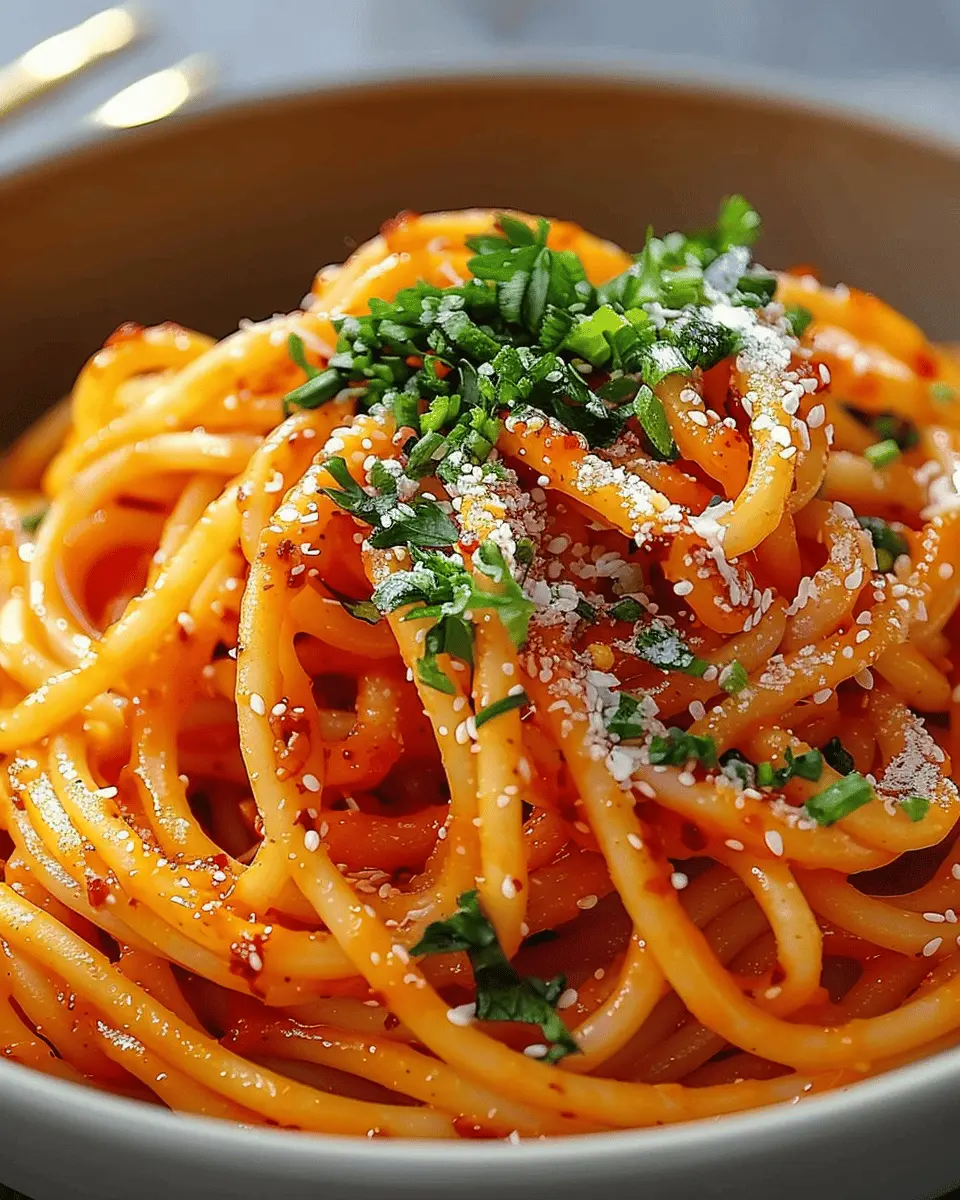
Serving Suggestions for Gochujang Pasta
Ideal Side Dishes to Complement Your Pasta
Pairing your gochujang pasta with the right side dishes can turn a simple meal into a culinary delight. Here are some fabulous options to consider:
- Crisp Salad: A fresh green salad with a light vinaigrette adds brightness and balances the rich flavors of the pasta. Consider using ingredients like cucumbers, cherry tomatoes, and arugula for a refreshing crunch.
- Grilled Vegetables: Season and grill seasonal veggies like bell peppers and zucchini. Their smoky sweetness beautifully complements the spicy notes of the gochujang.
- Garlic Bread: Who doesn’t love a slice of buttery garlic bread? It’s an easy choice that pairs wonderfully, perfect for mopping up any saucy leftovers.
Creative Ways to Serve and Enjoy
Now that your plate is ready, let’s explore some creative serving suggestions for your gochujang pasta.
- Top with Protein: Spice things up by adding proteins like diced chicken ham or turkey bacon for an extra savory kick. You could also try tofu for a vegetarian option!
- Garnish with Fresh Herbs: Sprinklings of cilantro or green onions can elevate your dish aesthetically and flavor-wise.
- Customize with Extra Heat: If you’re a heat lover, feel free to drizzle a bit more gochujang or some chili flakes on top.
Experimenting with these ideas not only enhances your meal but also makes it an enjoyable experience. For more inspiration, check out this guide to flavorful side dishes. Happy eating!
Time Breakdown for Gochujang Pasta
Preparation Time
Getting started with your gochujang pasta is a breeze! You’ll need about 10 minutes to gather your ingredients, chop veggies, and measure out your gochujang sauce. This is a great time to set out everything you need, making the cooking process smoother.
Cooking Time
Once you’re prepped, the cooking part takes around 15-20 minutes. You’ll quickly sauté your turkey bacon and other ingredients, stirring in that delicious gochujang sauce to give your dish a spicy kick.
Total Time
In just 30 minutes, you can whip up a fantastic bowl of gochujang pasta. Perfect for those busy weeknights or a weekend gathering with friends! If you’d like to dive deeper into different variations and serving ideas, check out this guide to pasta dishes on Food Network.
Nutritional Facts for Gochujang Pasta
When you’re whipping up a plate of gochujang pasta, it’s nice to know what you’re fueling your body with. Let’s break down the nutritional facts that make this dish a satisfying choice for any meal.
Calories
A typical serving of gochujang pasta contains about 400-500 calories, depending on your choice of ingredients, like the type of pasta and any added proteins. This makes it a respectable option for a main course without tipping the scales too much.
Protein
Each serving of your delicious gochujang pasta can pack around 15-20 grams of protein if you include protein-rich toppings like Turkey Bacon or Chicken Ham. Protein helps keep you full and satisfied, which is essential for busy young professionals on the go.
Sodium
It’s worth noting that one serving of gochujang pasta may have around 800-1000 mg of sodium, largely from the gochujang itself and any other sauces. If you’re watching your sodium intake, consider using low-sodium broth or adding fresh vegetables to balance it out.
For a deeper dive into how these nutritional elements affect your overall health, check out resources like the USDA Nutrient Database or consult with a professional nutritionist. Eating well doesn’t have to be complicated; just be mindful of what you’re adding to your plate!
FAQ about Gochujang Pasta
Can I make Gochujang Pasta ahead of time?
Absolutely! Gochujang Pasta is perfect for meal prep. You can cook the pasta and prepare the sauce ahead of time. Just store them separately in airtight containers in the fridge. When you’re ready to enjoy your dish, simply reheat the sauce and toss it with the pasta. You might want to add a splash of vegetable broth or water to loosen up the sauce if it has thickened.
What are some good substitutes for Gochujang?
If you find yourself without gochujang or prefer a milder flavor, there are a few alternatives you can consider:
- Sriracha: This chili sauce offers heat but lacks the fermented depth of gochujang. You may want to blend it with a bit of miso for added umami.
- Red pepper flakes: Combine these with a bit of soy sauce or miso paste to mimic the flavor profile.
- Chili paste: Look for versions that contain fewer additives and more natural ingredients.
Exploring substitutes can lead to some exciting variations, so don’t hesitate to get creative!
How can I make Gochujang Pasta less spicy?
If you’re sensitive to spice, don’t worry! Here are some easy ways to tone down the heat in your gochujang pasta:
- Reduce the amount of gochujang: Start with a smaller quantity and gradually add more to taste.
- Add sweetness: Incorporating a dash of honey or brown sugar can balance the heat.
- Cream or Coconut Milk: Stir in some cream or coconut milk to create a richer, milder sauce.
Remember, cooking is all about personal taste, so feel free to adjust the recipe until it’s just right for you. For more tips and inspiration, you can explore Healthline for health benefits and cooking ideas.
Conclusion on Gochujang Pasta
Embracing Homemade Goodness with Gochujang Pasta
Cooking at home can be a delightful adventure, and gochujang pasta offers a beautiful blend of flavors that tantalize the palate. This dish not only celebrates the rich, spicy kick of gochujang but also provides the versatility to cater to everyone’s taste. Whether using Turkey Bacon for savory notes or adding veggies for a health boost, the options are nearly endless.
So, why settle for takeout when you can whip up a quick and delicious meal in your own kitchen? Dive into the world of gochujang pasta today, and experience the joy of homemade goodness. For more inspiration and tips, check out sites like Serious Eats and Bon Appétit to elevate your cooking game further!
PrintGochujang Pasta: A Spicy and Indulgent Twist on Comfort Food
A delightful fusion of spicy gochujang and creamy pasta, perfect for those seeking a comforting yet zesty meal.
- Prep Time: 10 minutes
- Cook Time: 10 minutes
- Total Time: 20 minutes
- Yield: 2 servings 1x
- Category: Main Course
- Method: Boiling and Tossing
- Cuisine: Korean Fusion
- Diet: Vegetarian
Ingredients
- 200 grams pasta of choice
- 3 tablespoons gochujang
- 1 tablespoon soy sauce
- 2 tablespoons sesame oil
- 1 tablespoon honey
- 2 cloves garlic, minced
- 1 teaspoon fresh ginger, grated
- 2 tablespoons green onions, chopped
- sesame seeds for garnish
Instructions
- Cook the pasta according to package instructions until al dente.
- In a bowl, whisk together gochujang, soy sauce, sesame oil, honey, garlic, and ginger.
- Drain the pasta and return it to the pot.
- Add the sauce to the pasta and toss to combine, ensuring the pasta is evenly coated.
- Stir in the chopped green onions.
- Serve immediately, garnished with sesame seeds.
Notes
- This pasta can be kept spicy or adjusted to your taste by modifying the amount of gochujang.
- Adding vegetables such as bell peppers or spinach can enhance the dish.
Nutrition
- Serving Size: 1 serving
- Calories: 450
- Sugar: 6 grams
- Sodium: 800 milligrams
- Fat: 15 grams
- Saturated Fat: 2 grams
- Unsaturated Fat: 10 grams
- Trans Fat: 0 grams
- Carbohydrates: 66 grams
- Fiber: 3 grams
- Protein: 12 grams
- Cholesterol: 0 milligrams
Keywords: Gochujang Pasta, Spicy Pasta, Comfort Food

